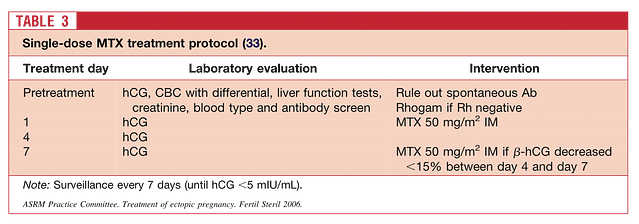
Historically, ectopic pregnancy (EP) was treated surgically. For the past 20 years or so, methotrexate (MTX) has been used for the medical management of EP. In carefully selected patients, a single intramuscular (IM) dose of MTX will work 90% of the time. Here are some of the facts about MTX and EP.
Methotrexate destroys rapidly dividing cells by interfering with their metabolism (folic acid antagonist). In high and repeated doses, it is effective for treating cancer. However, a single dose of MTX is often sufficient to treat EP. A second dose (given a week later) may be required in up to 15% of cases.
Ideally, a candidate for medical management with MTX should meet the following criteria: [a] hemodynamic stability, [b] no severe or persistent abdominal pain, [c] commitment to follow-up until the EP has resolved, and [d] normal baseline liver and renal function tests.
MTX should not be used in patients with an intrauterine pregnancy, evidence of immunodeficiency, low blood counts, allergy to MTX, active lung, liver, kidney or peptic ulcer disease. It is also to be avoided in patients who are breast-feeding, or those that will not or are unable for repeat office follow up visits.
MTX has a high failure rate in patients where the EP demonstrates a heartbeat, the initial hCG level is high (> 5000 mIU/mL) or if the EP is > 4 cm in size. The presence of blood in the pelvis, rapidly increasing hCG concentrations (>50%/ 48 hours) before MTX and continued rapid rise in hCG concentrations during MTX are also associated with a high failure rate.
A normal intrauterine pregnancy MUST be ruled out prior to giving a patient MTX. If MTX is inadvertently given to a normal pregnancy, there is a very high incidence of the baby having serious birth defects.
A commonly used treatment protocol is illustrated in Table 1.
 Complete resolution of an EP usually takes between 2 and 3 weeks but can take as long as 6 to 8 weeks when pretreatment hCG levels are in higher ranges.
Complete resolution of an EP usually takes between 2 and 3 weeks but can take as long as 6 to 8 weeks when pretreatment hCG levels are in higher ranges.
Women undergoing treatment with methotrexate should avoid: intercourse, pelvic exams, TVU, sun exposure (due to the risk of methotrexate dermatitis), foods and vitamins containing folic acid (including prenatal vitamins), and gas-forming foods.
After medical treatment with MTX, 78% of patients will have patent tubes. Of patients who try and get pregnant again, 65% will succeed. The incidence of a repeat EP is 6 – 13%.
Most women will have no side effects from a single dose of MTX. Rare side effects include stomach upset, nausea, vomiting, mouth ulcers, dizziness, low blood counts, hair loss.

Dr. Karande is Board Certified in the specialty of Obstetrics and Gynecology as well as the subspecialty of Reproductive Endocrinology and Infertility. He is a Fellow of the American College of Obstetricians and Gynecologists and Member of the American Society for Reproductive Medicine.
Subscribe to our weekly blog digest

Entire Website © 2003 - 2020
Karande and Associates d/b/a InVia
Fertility Specialists

Comments